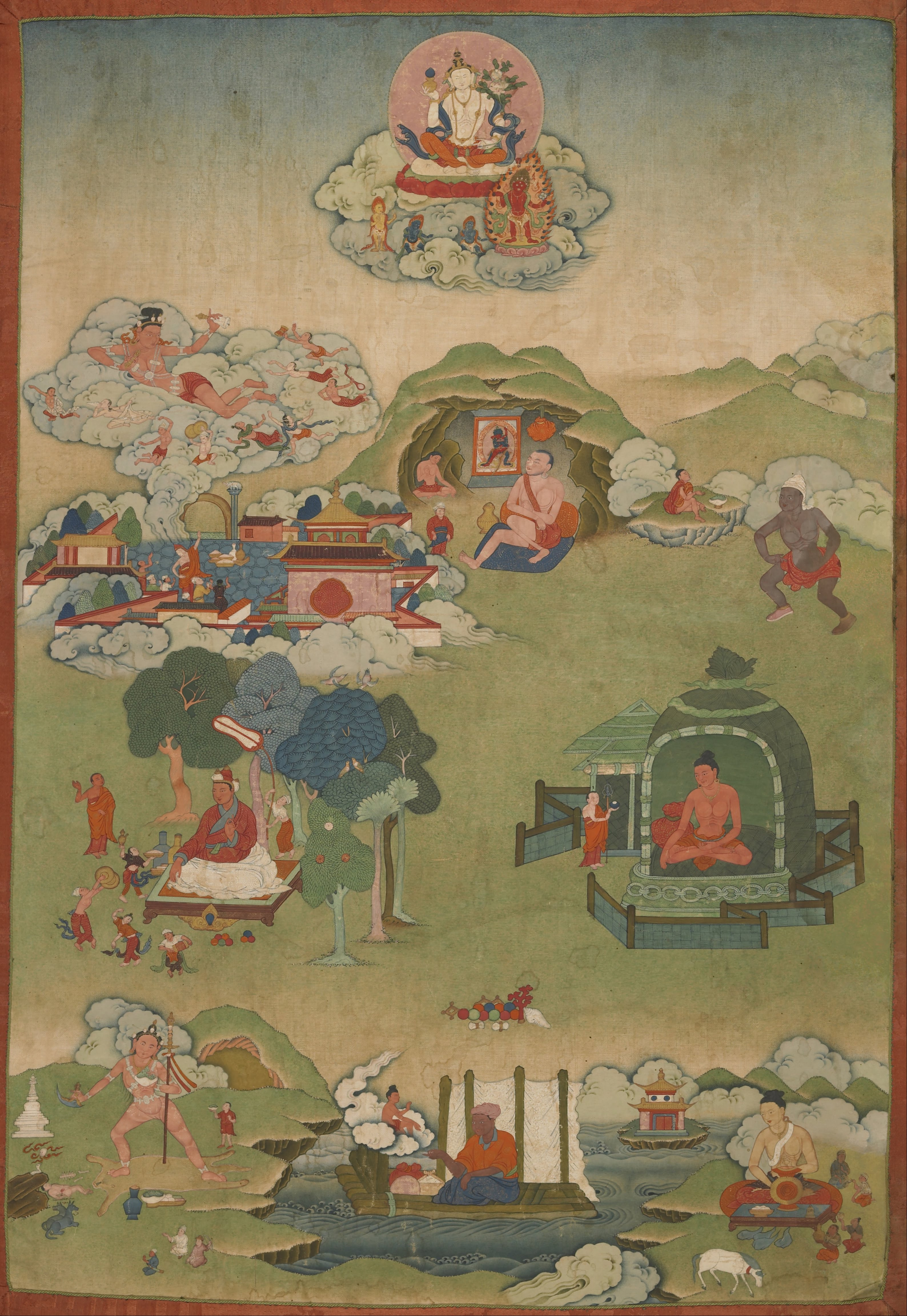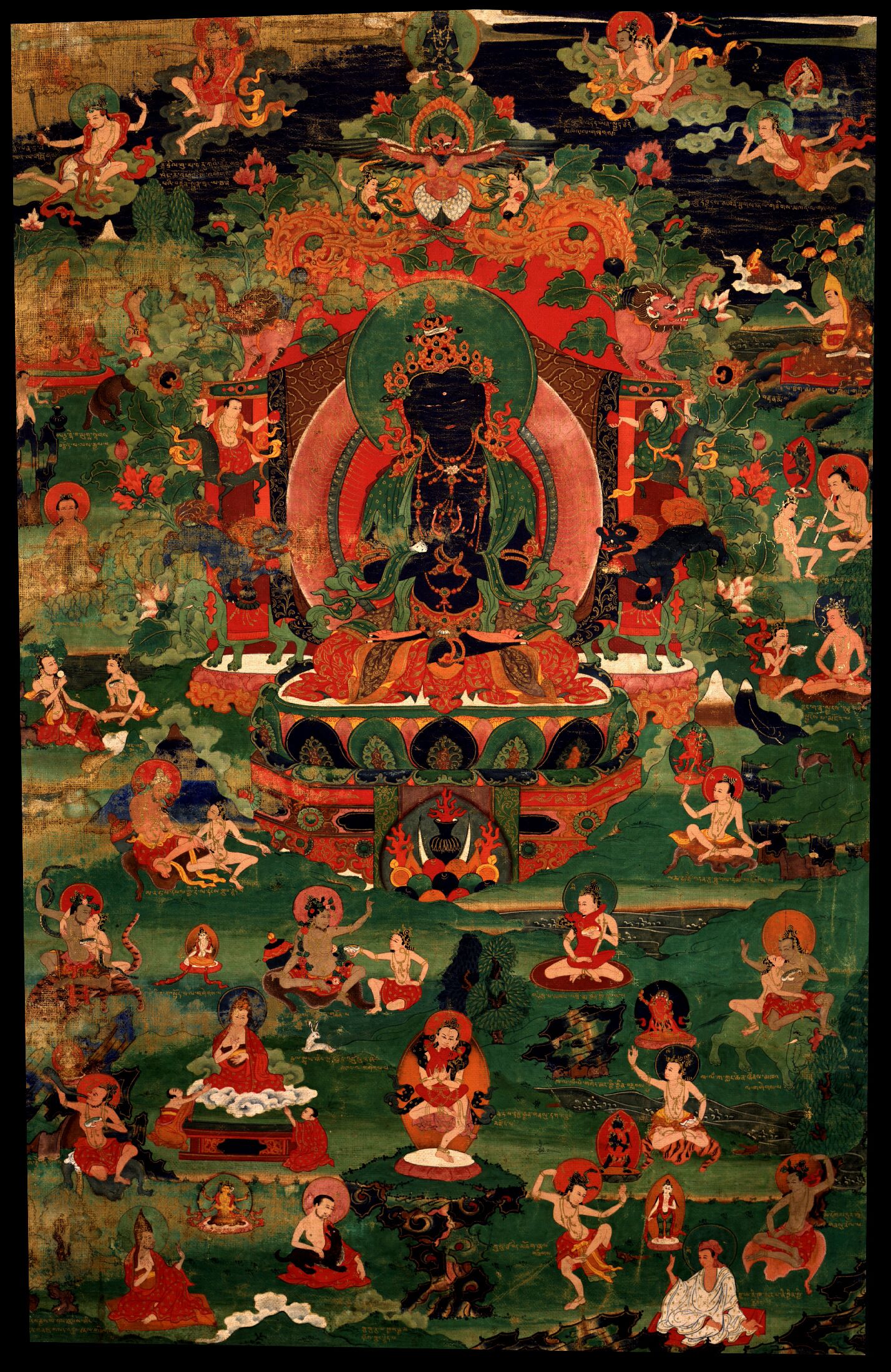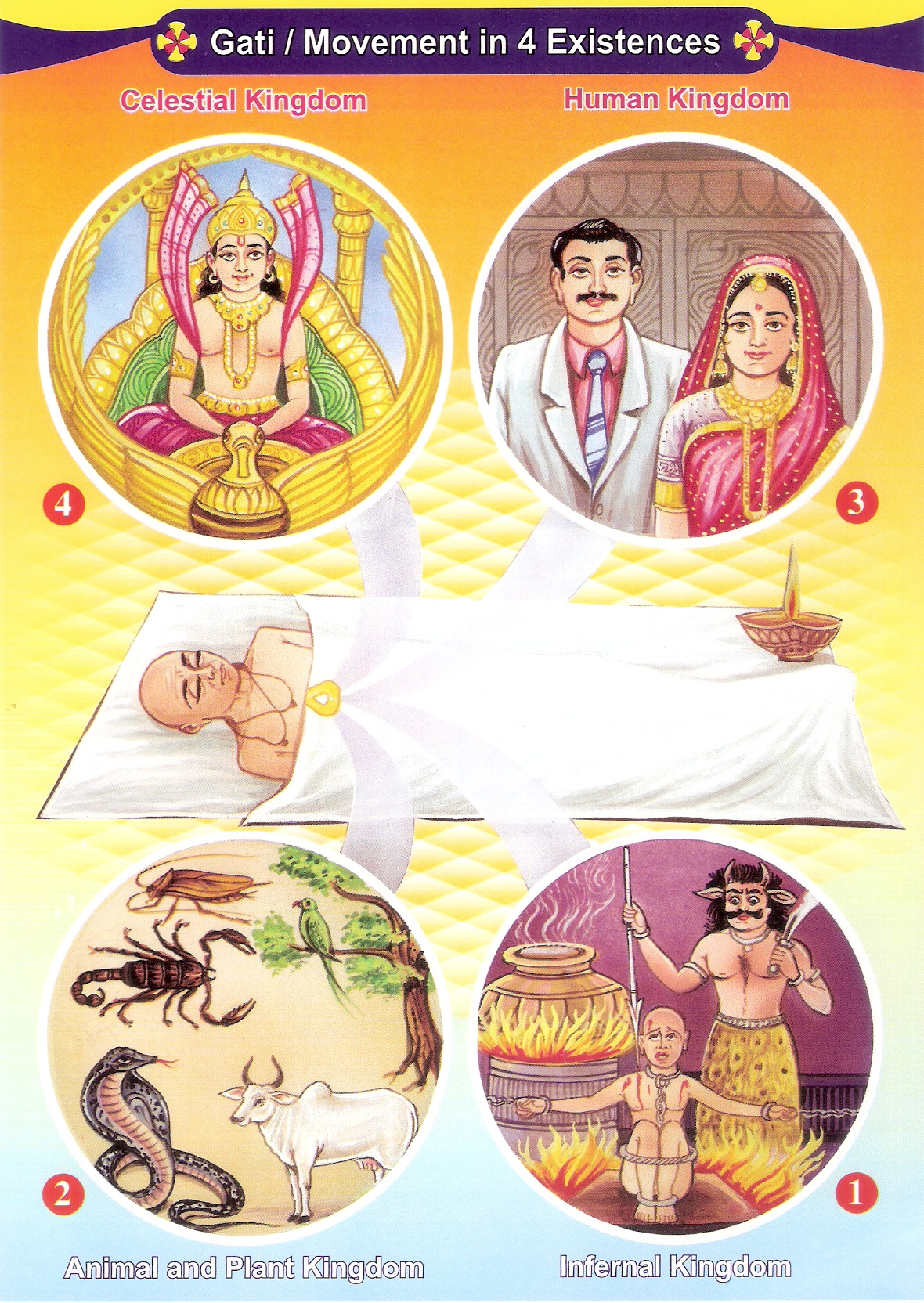|
Tiphupa
Tiphupa was an Indian Buddhist teacher from the 11th and 12th century who was considered to be the rebirth of Darma Dode, son and student of Tibetan lama Marpa Lotsawa. When young Darma Dode died in an accident his father with the special abilities of a realized lama, managed to prolong his son's life for a while. It was enough time for Marpa to teach him how to transfer his consciousness into a dead body – in this case the body of a dead pigeon. Following the detailed instructions of the teacher, the pigeon flew to India and died next to a sixteen-year-old boy who had recently lost his life. Transferring again his consciousness, this time to the young boy's body, gave life to the Indian teacher Tiphupa (from Ti Phu – pigeon). When the boy returned home it was evident that Tiphupa was very different from who he had been before. He kept taking care of his aging parents as a normal son and they considered him as a guru. Tiphupa intensively practiced the methods taught by Marpa a ... [...More Info...] [...Related Items...] OR: [Wikipedia] [Google] [Baidu] |
Kagyu
The ''Kagyu'' school, also transliterated as ''Kagyü'', or ''Kagyud'' (), which translates to "Oral Lineage" or "Whispered Transmission" school, is one of the main schools (''chos lugs'') of Tibetan (or Himalayan) Buddhism. The Kagyu lineages trace themselves back to the 11th century Indian Mahasiddhas Naropa, Maitripa and the yogini Niguma, via their student Marpa Lotsawa (1012–1097), who brought their teachings to Tibet. Marpa's student Milarepa was also an influential poet and teacher. The Tibetan Kagyu tradition gave rise to a large number of independent sub-schools and lineages. The principal Kagyu lineages existing today as independent schools are those which stem from Milarepa's disciple, Gampopa (1079–1153), a monk who merged the Kagyu lineage with the Kadam tradition. The Kagyu schools which survive as independent institutions are mainly the Karma Kagyu, Drikung Kagyu, Drukpa Lineage and the Taklung Kagyu. The Karma Kagyu school is the largest of the sub-schoo ... [...More Info...] [...Related Items...] OR: [Wikipedia] [Google] [Baidu] |
Kagyu Lamas
The ''Kagyu'' school, also transliterated as ''Kagyü'', or ''Kagyud'' (), which translates to "Oral Lineage" or "Whispered Transmission" school, is one of the main schools (''chos lugs'') of Tibetan (or Himalayan) Buddhism. The Kagyu lineages trace themselves back to the 11th century Indian Mahasiddhas Naropa, Maitripa and the yogini Niguma, via their student Marpa Lotsawa (1012–1097), who brought their teachings to Tibet. Marpa's student Milarepa was also an influential poet and teacher. The Tibetan Kagyu tradition gave rise to a large number of independent sub-schools and lineages. The principal Kagyu lineages existing today as independent schools are those which stem from Milarepa's disciple, Gampopa (1079–1153), a monk who merged the Kagyu lineage with the Kadam tradition. The Kagyu schools which survive as independent institutions are mainly the Karma Kagyu, Drikung Kagyu, Drukpa Lineage and the Taklung Kagyu. The Karma Kagyu school is the largest of the sub-school ... [...More Info...] [...Related Items...] OR: [Wikipedia] [Google] [Baidu] |
Buddhism
Buddhism ( , ), also known as Buddha Dharma and Dharmavinaya (), is an Indian religion or philosophical tradition based on teachings attributed to the Buddha. It originated in northern India as a -movement in the 5th century BCE, and gradually spread throughout much of Asia via the Silk Road. It is the world's fourth-largest religion, with over 520 million followers (Buddhists) who comprise seven percent of the global population. The Buddha taught the Middle Way, a path of spiritual development that avoids both extreme asceticism and hedonism. It aims at liberation from clinging and craving to things which are impermanent (), incapable of satisfying ('), and without a lasting essence (), ending the cycle of death and rebirth (). A summary of this path is expressed in the Noble Eightfold Path, a training of the mind with observance of Buddhist ethics and meditation. Other widely observed practices include: monasticism; " taking refuge" in the Buddha, the , and the ; ... [...More Info...] [...Related Items...] OR: [Wikipedia] [Google] [Baidu] |
Milarepa
Jetsun Milarepa (, 1028/40–1111/23) was a Tibetan siddha, who was famously known as a murderer when he was a young man, before turning to Buddhism and becoming a highly accomplished Buddhist disciple. He is generally considered one of Tibet's most famous yogis and spiritual poets, whose teachings are known among several schools of Tibetan Buddhism. He was a student of Marpa Lotsawa, and a major figure in the history of the Kagyu school of Tibetan Buddhism. He is also famous for the feat of climbing Mount Kailash. Biography — ''The Life of Milarepa'' Milarepa's life-story is famous in Tibetan culture, and retold many times. The best-known biography, ''The Life of Milarepa'', written by Tsangnyön Heruka (1452–1507) in the fifteenth century and drawing from older biographies, is still very popular. Most of the present-day stories on Milarepa come from this single source, with oral lineage predominating as well as relics including his bearskin coat. While "very little s kno ... [...More Info...] [...Related Items...] OR: [Wikipedia] [Google] [Baidu] |
Mahasiddhas
Mahasiddha (Sanskrit: ''mahāsiddha'' "great adept; ) is a term for someone who embodies and cultivates the "siddhi of perfection". A siddha is an individual who, through the practice of sādhanā, attains the realization of siddhis, psychic and spiritual abilities and powers. Mahasiddhas were practitioners of yoga and tantra, or ''tantrika''s. Their historical influence throughout the Indian subcontinent and the Himalayas was vast and they reached mythic proportions as codified in their songs of realization and hagiographies, or namtars, many of which have been preserved in the Tibetan Buddhist canon. The Mahasiddhas are the founders of Vajrayana traditions and lineages such as Dzogchen and Mahamudra. Robert Thurman explains the symbiotic relationship between Tantric Buddhist communities and the Buddhist universities such as Nalanda which flourished at the same time. Genealogy and historical dates The exact genealogy and historical dates of the Mahasiddhas are contentious. D ... [...More Info...] [...Related Items...] OR: [Wikipedia] [Google] [Baidu] |
Bodhisattvas
In Buddhism, a bodhisattva ( ; sa, 𑀩𑁄𑀥𑀺𑀲𑀢𑁆𑀢𑁆𑀯 (Brahmī), translit=bodhisattva, label=Sanskrit) or bodhisatva is a person who is on the path towards bodhi ('awakening') or Buddhahood. In the Early Buddhist schools as well as modern Theravada Buddhism, a bodhisattva (Pali: ''bodhisatta'') refers to someone who has made a resolution to become a Buddha and has also received a confirmation or prediction from a living Buddha that this will be so. In Mahayana Buddhism, a bodhisattva refers to anyone who has generated ''bodhicitta'', a spontaneous wish and compassionate mind to attain Buddhahood for the benefit of all sentient beings. Mahayana bodhisattvas are spiritually heroic persons that work to attain awakening and are driven by a great compassion (''mahakaruṇā''). These beings are exemplified by important spiritual qualities such as the "four divine abodes" (''brahmaviharas'') of loving-kindness ('' metta''), compassion (''karuṇā''), empatheti ... [...More Info...] [...Related Items...] OR: [Wikipedia] [Google] [Baidu] |
Dakini
A ḍākinī ( sa, डाकिनी; ; mn, хандарма; ; alternatively 荼枳尼, ; 荼吉尼, ; or 吒枳尼, ; Japanese: 荼枳尼 / 吒枳尼 / 荼吉尼, ''dakini'') is a type of female spirit, goddess, or demon in Hinduism and Buddhism. The concept of the ḍākinī somewhat differs depending on the context and the tradition. For instance, in earlier Hindu texts and East Asian esoteric Buddhism, the term denotes a race of demonesses who ate the flesh and/or vital essence of humans. In Hindu Tantric literature, Ḍākinī is the name of a goddess often associated with one of the six chakras or the seven fundamental elements ('' dhātu'') of the human body. In Nepalese and Tibetan Buddhism, meanwhile, 'ḍākinī' (also wisdom ḍākinī) can refer to both what can be best described as fierce-looking female embodiments of enlightened energy and to human women with a certain amount of spiritual development, both of which can help Tantric initiates attaining enli ... [...More Info...] [...Related Items...] OR: [Wikipedia] [Google] [Baidu] |
Rechungpa
Rechung Dorje Drakpa (, 1083/4-1161), known as Rechungpa, was one of the two most important students of the 11th century yogi and poet Milarepa and founder of the Rechung Kagyu subtradition of the Kagyu school of Tibetan Buddhism. (The other student was Gampopa, founder of the Dagpo Kagyu). Rechungpa was particularly important in the transmission of the cycle of esoteric teachings of the ''Cakrasaṃvara Tantra'' known as the Demchok Nyéngyü (), Réchung Nyéngyü (). Tibetan Buddhists believe Rechungpa compiled ''The Six Equal Tastes'' from Indian sources. The text was hidden by Rechungpa, later recovered as a terma by Tsangpa Gyare, who founded the Drukpa Lineage. Rechungpa's student Gyalwa Kyang Tsangpa transmitted the Rechung Kagyu lineage to the 12th century yogini Machik Ongyo. This lineage has been similarly transmitted without interruption until the present time. For example, Changling Rinpoche XV is one of the few holders of this lineage today, though in western teach ... [...More Info...] [...Related Items...] OR: [Wikipedia] [Google] [Baidu] |
Mahasiddha
Mahasiddha (Sanskrit: ''mahāsiddha'' "great adept; ) is a term for someone who embodies and cultivates the " siddhi of perfection". A siddha is an individual who, through the practice of sādhanā, attains the realization of siddhis, psychic and spiritual abilities and powers. Mahasiddhas were practitioners of yoga and tantra, or ''tantrika''s. Their historical influence throughout the Indian subcontinent and the Himalayas was vast and they reached mythic proportions as codified in their songs of realization and hagiographies, or namtars, many of which have been preserved in the Tibetan Buddhist canon. The Mahasiddhas are the founders of Vajrayana traditions and lineages such as Dzogchen and Mahamudra. Robert Thurman explains the symbiotic relationship between Tantric Buddhist communities and the Buddhist universities such as Nalanda which flourished at the same time. Genealogy and historical dates The exact genealogy and historical dates of the Mahasiddhas are contentiou ... [...More Info...] [...Related Items...] OR: [Wikipedia] [Google] [Baidu] |
Reincarnation
Reincarnation, also known as rebirth or transmigration, is the philosophical or religious concept that the non-physical essence of a living being begins a new life in a different physical form or body after biological death. Resurrection is a similar process hypothesized by some religions, in which a soul comes back to life in the same body. In most beliefs involving reincarnation, the soul is seen as immortal and the only thing that becomes perishable is the body. Upon death, the soul becomes transmigrated into a new infant (or animal) to live again. The term transmigration means passing of soul from one body to another after death. Reincarnation (''Punarjanma'') is a central tenet of the Indian religions such as Buddhism, Hinduism, Jainism, and Sikhism; as well as certain Paganist religious groups, although there are Hindu and Buddhist groups who do not believe in reincarnation, instead believing in an afterlife. In various forms, it occurs as an esoteric belief in many s ... [...More Info...] [...Related Items...] OR: [Wikipedia] [Google] [Baidu] |
Naropa
Nāropā (Prakrit; sa, Nāropāda, Naḍapāda or Abhayakirti) or Abhayakirti was an Indian Buddhist Mahasiddha. He was the disciple of Tilopa and brother, or some sources say partner and pupil, of Niguma. As an Indian Mahasiddha, Naropa's instructions inform Vajrayana, particularly his six yogas of Naropa relevant to the completion stage of anuttarayogatantra. He was also one of the gatekeepers of Vikramashila monastery which is located in Bihar. Although some accounts relate that Naropa was the personal teacher of Marpa Lotsawa, other accounts suggest that Marpa held Naropa's lineage through intermediary disciples only. Names According to scholar John Newman, "the Tibetans give Nāro's name as ''Nā ro pa, Nā ro paṇ chen, Nā ro ta pa,'' and so forth. The manuscript of the ''Paramarthasaṃgraha'' preserves a Sanskrit form ''Naḍapāda'' (''Paramarthasaṃgraha'' 74). A Sanskrit manuscript edited by Tucci preserves an apparent Prakrit form ''Nāropā'', as well as a ... [...More Info...] [...Related Items...] OR: [Wikipedia] [Google] [Baidu] |
Guru
Guru ( sa, गुरु, IAST: ''guru;'' Pali'': garu'') is a Sanskrit term for a "mentor, guide, expert, or master" of certain knowledge or field. In pan-Indian traditions, a guru is more than a teacher: traditionally, the guru is a reverential figure to the disciple (or '' shisya'' in Sanskrit, literally ''seeker f knowledge or truth'' or student, with the guru serving as a "counselor, who helps mold values, shares experiential knowledge as much as literal knowledge, an exemplar in life, an inspirational source and who helps in the spiritual evolution of a student". Whatever language it is written in, Judith Simmer-Brown explains that a tantric spiritual text is often codified in an obscure twilight language so that it cannot be understood by anyone without the verbal explanation of a qualified teacher, the guru. A guru is also one's spiritual guide, who helps one to discover the same potentialities that the ''guru'' has already realized. The oldest references to the concep ... [...More Info...] [...Related Items...] OR: [Wikipedia] [Google] [Baidu] |









